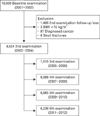Abstract
Regular exercise and a certain level of physical activity reduce the mortality rate in the elderly. The purpose of this study was to investigate the effect of physical activity on the prevention of fracture in the middle aged or older in Korea. The basic data are based on the Ansan and Ansung community cohort studies of the Korean Genome and Epidemiology Study conducted by the Korea Centers for Disease Control and Prevention in 2001, and the fracture data from the third survey in 2005 to the sixth survey in 2011. The physical activity of the aged in the 40s was mostly distributed in the World Health Organization (WHO) recommended range of 7.5 to 30.0 metabolic equivalent·hr/wk, and the activity was gradually divided into the low and high groups in the 50s and 60s. In the 60s, the risk of fracture was reduced to 0.63 times compared to that of the 50s when physical activity was the recommended level (odds ratio, 0.63; p<0.001). For Korean adults, there was no significant difference in fracture incidence according to the amount of physical activity in the middle-aged people. However, for the elderly aged 60 and over, the risk of fracture decreased when the WHO recommended level of activity was performed, and the risk increased when less or more activities were performed.
Figures and Tables
Table 1
Baseline characteristics of participants by MET-hours per week of activity in the cohort study

Table 2
Associations between physical activity and incidence of fractures

OR: odds ratio, CI: confidence interval, PA: physical activity, MET: metabolic equivalent.
*Model 1: not adjusted; †Model 2: adjusted for sex, body mass index, fat mass index, fat free mass index, axial speed of sound at radius, axial speed of sound at tibia, smoking status, drinking status, education level, marital status, comorbidity, osteoporosis medication state.
References
1. Peris P, Ruiz-Esquide V, Monegal A, et al. Idiopathic osteoporosis in premenopausal women: clinical characteristics and bone remodelling abnormalities. Clin Exp Rheumatol. 2008; 26:986–991.
2. Kang BJ, Lee YK, Lee KW, Won SH, Ha YC, Koo KH. Mortality after hip fractures in nonagenarians. J Bone Metab. 2012; 19:83–86.
3. Kanis JA, Johnell O, Oden A, Johansson H, McCloskey E. FRAX and the assessment of fracture probability in men and women from the UK. Osteoporos Int. 2008; 19:385–397.
4. Cauley JA, Cawthon PM, Peters KE, et al. Risk factors for hip fracture in older men: the Osteoporotic Fractures in Men Study (MrOS). J Bone Miner Res. 2016; 31:1810–1819.
5. Visser M, Schaap LA. Consequences of sarcopenia. Clin Geriatr Med. 2011; 27:387–399.
6. Arem H, Moore SC, Patel A, et al. Leisure time physical activity and mortality: a detailed pooled analysis of the dose-response relationship. JAMA Intern Med. 2015; 175:959–967.
7. Barrett-Connor E, Siris ES, Wehren LE, et al. Osteoporosis and fracture risk in women of different ethnic groups. J Bone Miner Res. 2005; 20:185–194.
8. Simkin A, Ayalon J, Leichter I. Increased trabecular bone density due to bone-loading exercises in postmenopausal osteoporotic women. Calcif Tissue Int. 1987; 40:59–63.
9. Korea Centers for Disease Control and Prevention. Korean genome and epidemiology study [Internet]. Cheongju (KR): Korea Centers for Disease Control and Prevention;c2014. cited 2017 Feb 15. Available from: http://www.cdc.go.kr.
10. Jordan S, Lim L, Berecki-Gisolf J, et al. Body mass index, physical activity, and fracture among young adults: longitudinal results from the Thai cohort study. J Epidemiol. 2013; 23:435–442.
11. Jeon JY. Development of the Korean version of Global Physical Activity Questionnaire and assessment of reliability and validity [Internet]. Cheongju (KR): Korea Centers for Disease Control and Prevention;c2013. cited 2017 Aug 13. Available from: http://www.cdc.go.kr.
12. Buchner DM, Bishop J, Brown DR, et al. 2008 Physical activity guidelines for Americans [Internet]. Washington: U.S: Department of Health and Human Services;c2008. cited 2017 Aug 13. Available from: https://health.gov/paguidelines/guidelines/.
13. Ling CH, de Craen AJ, Slagboom PE, et al. Accuracy of direct segmental multi-frequency bioimpedance analysis in the assessment of total body and segmental body composition in middle-aged adult population. Clin Nutr. 2011; 30:610–615.
14. NIH Consensus Development Panel on Osteoporosis Prevention, Diagnosis, and Therapy. Osteoporosis prevention, diagnosis, and therapy. JAMA. 2001; 285:785–795.
15. Tao B, Liu JM, Li XY, Wang JG, Wang WQ, Ning G. An assessment of the use of quantitative ultrasound and the osteoporosis self-assessment tool for Asians in determining the risk of nonvertebral fracture in postmenopausal Chinese women. J Bone Miner Metab. 2008; 26:60–65.
16. Lee SH, Khang YH, Lim KH, et al. Clinical risk factors for osteoporotic fracture: a population-based prospective cohort study in Korea. J Bone Miner Res. 2010; 25:369–378.
17. Cosman F, de Beur SJ, LeBoff MS, et al. Clinician's guide to prevention and treatment of osteoporosis. Osteoporos Int. 2014; 25:2359–2381.
18. Knapik JJ, Reynolds K, Hoedebecke KL. Stress fractures: etiology, epidemiology, diagnosis, treatment, and prevention. J Spec Oper Med. 2017; 17:120–130.
19. Muir JM, Ye C, Bhandari M, Adachi JD, Thabane L. The effect of regular physical activity on bone mineral density in post-menopausal women aged 75 and over: a retrospective analysis from the Canadian multicentre osteoporosis study. BMC Musculoskelet Disord. 2013; 14:253.
20. Honkanen K, Honkanen R, Heikkinen L, Kroger H, Saarikoski S. Validity of self-reports of fractures in perimenopausal women. Am J Epidemiol. 1999; 150:511–516.
21. Hartley S, Garland S, Young E, et al. A comparison of selfreported and objective physical activity measures in young Australian women. JMIR Public Health Surveill. 2015; 1:e14.
22. Chen LK, Liu LK, Woo J, et al. Sarcopenia in Asia: consensus report of the Asian Working Group for Sarcopenia. J Am Med Dir Assoc. 2014; 15:95–101.
23. Kemmler W, Haberle L, von Stengel S. Effects of exercise on fracture reduction in older adults: a systematic review and meta-analysis. Osteoporos Int. 2013; 24:1937–1950.




 PDF
PDF ePub
ePub Citation
Citation Print
Print



 XML Download
XML Download